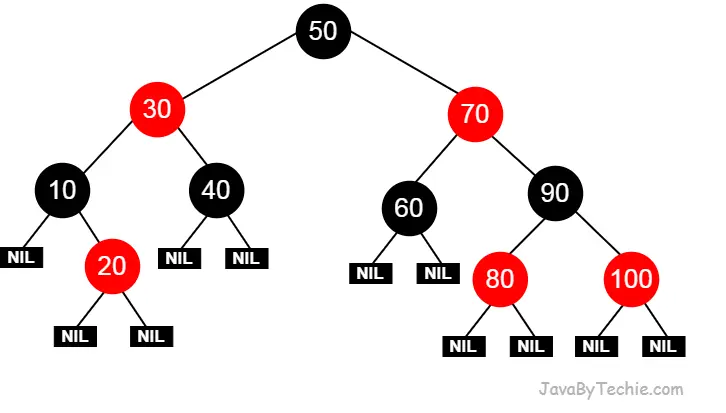

Last Updated: 18 January, 2025 6 Mins Read
A Red-Black tree is a type of self-balancing binary search tree in which every node is colored either RED or BLACK. The properties of a Red-Black tree decide the color of a node.
In the Red-black tree, every node contains an extra bit that represents a color to ensure that the tree is balanced during any operations performed on the tree, like insertion, deletion, etc.
The Red-Black Tree is introduced by Rudolf Bayer in the year 1972.
Red-Black Tree always be a Binary Search Tree (BST).
Each node in a Red-Black tree will be either RED or BLACK in color.
The ROOT node must be colored BLACK.
All the child nodes of RED colored node must be colored BLACK. (Two consecutive RED nodes not possible in the tree).
There should be the same number of BLACK colored nodes in all the paths of the tree.
Every leaf node (also called NULL or NIL node) must be colored BLACK.

In the given tree above, all the nodes are satisfying all the properties of a Red-Black Tree.
A Red-Black Tree data structure provides fast and efficient access to sorted data. It allows us to save any type of data that can be compared, including numbers, strings, dates, and objects. It can also handle dynamic operations like data insertion and deletion without impacting the tree's performance or balanced structure.
A red-black tree can also be used to build abstract data types like sets, maps, and priority queues.
In a Red-Black Tree, we can perform the following types of operations.
Output
R----45(BLACK)
L----30(BLACK)
| L----25(RED)
R----60(BLACK)
L----50(RED)
R----70(RED)
After deleting an element:
R----45(BLACK)
L----30(BLACK)
| L----25(RED)
R----60(BLACK)
L----50(RED)
There are the following scenarios where we can use Red-Black Tree:
There are the following scenarios where we should avoid the uses of Red-Black Tree:
| Feature | Red-Black Tree | AVL Tree |
|---|---|---|
| Balanced | Less balanced | More balanced |
| Insertion/Deletion | Faster (fewer rotations required) | Slower (more rotations required) |
| Searching | Less efficient | Efficient search operations |
| Node color | Either red or black | No color |
| Balance factor | No balance factor for each node | All the nodes contain a balance factor (-1, 0, 1) |
| Processing time | Takes less | Takes more |
Red-Black Trees are a powerful and versatile data structure that provides a good balance between performance and complexity. They are particularly useful in scenarios where data is dynamic and ordered traversal is required. However, their complexity and overhead make them less suitable for small datasets or applications where simpler structures suffice.
That's all, guys. I hope this article is helpful for you.
Happy Learning... 😀
feedback@javabytechie.com